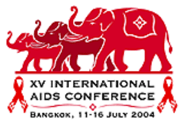 |
 |
 |
| |
ONCE DAILY PI REGIMEN 1600/100 SQV-hgc/r: 24 week results
|
| |
| |
|
|
| |
| |
 |
|
| |
| |
Reported by Jules Levin
"A Prospective Cohort Study of Efficacy and Safety of 2 NRTIs plus once-daily Ritonavir boosted-Saquinavir Hard Gel Capsule (SQV-HGC/r) at 24 weeks"
This study was presented at Bangkok by Ananworanich and colleagues (HIV NAT, Bangkok, Thailand, Poster B4469). Here is their presentation.
Once daily ritonavir-boosted saquinavir (SQV-sgc/r od) 1600/100 mg has previously been shown to be effective and have acceptable pharmacokinetic (PK) parameters in HIV+ subjects.
SQV-hgc has been shown to have equivalent PK parameters to SQV-sgc when used in combination with RTV.
There has been no data to date on the treatment outcome of once daily saquinavir hard gel capsule/ritonavir (SQV-HGC/r)-based HAART.
Roche is reintroducing Invirase, the original saquinavir. They are manufacturing & submitting to the FA approval for 500 mg pills of Invirase, so upon availability & approval 1600 mg saquinavir for a once daily regimen will consist of 3 pills of Invirase plus 1 pill for 1 mg ritonavir.
METHODS
The first 167 ARV-naïve Thai patients enrolled in the Staccato study between Jan 2002 to July 2003 and treated continuously with d4T (30 or 40 mg twice daily) and ddI (250 or 400 mg once daily) according to weight /SQV-HGC (1600 mg once daily), and ritonavir (100 mg once daily) for at least 24 weeks were included. Patients were followed every 2 months. Intent to treat analysis was performed.
Seventy four (56%) men and 93 (44%) women participated, with a mean age of 34.8 years, median CD4 265 and median HIV RNA 4.7 log., CDC (87%),, B (11%), C (2%).
RESULTS 24 WEEKS
Two patients were lost to followup.
HIV RNA levels of <400 copies/ml and <50 copies/ml were seen in 95% and 91% of patients, respectively (intent-to-treat analysis); p<0.001 and p<0.01 vs baseline, respectively.
There was a median HIV RNA change from baseline of --2.9 log (p<0.001).
The median CD4 count was 380 (p<0.001 vs baseline). There was a median change from baseline of 109 cells.
Fifteen patients (9%) had new CDC class B, HIV related illnesses, but none had class C illnesses.
ARV-related adverse events were seen in 74 patients (44%):
--grade 1 (78%)
--grade 2 (22%)
--grade 3 or 4 (0%)
The most common ARV-related AEs were diarrhea (19%), nausea/vomiting (12%) and peripheral neuropathy (13%).
Sixteen patients (9%) switched from d4T/ddI to tenofovir/3TC according to a revised study protocol dictating the switch for all patients.
Nine (5%) patients temporarily stopped ARV therapy owing to hyperlactatemia 1, worsening neuropathy 1, suspected drug allergy 1, gastrointestinal symptoms 1, non-compliance 3, and herpes simplex infection 1. One patient stopped TDF/3TC because of dizziness, nausea and vomiting. In the patient with hyperlactatemia the d4T dose was reduced; in all other patients the original therapy was subsequently recommenced.
AUTHOR DISCUSSION
Once daily SQV-hgc with a d4T/ddI backbone showed excellent efficacy over 24 weeks, with more than 90% of patients achieving an HIV RNA level <50 copies/ml and CD4 increase of >100 cells. Although adverse events were common, they were mostly mild and self-limiting, with no patient experiencing severe or life threatening AEs.
|
| |
|
 |
 |
|
|